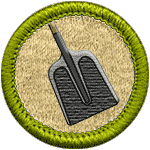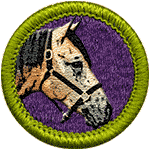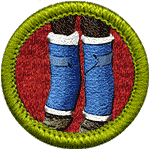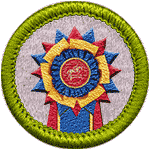EDU 563, William Woods University
Karen Pautz
Fall Term 1 2013
Badges: A method of displaying equine industry-specific skills











Introduction: For university students intent on securing a job in the horse industry, the diploma and grade report are surprisingly useless things. Horse employers are notoriously unimpressed by a baccalaureate degree -- instead, they want to know what specific skills their potential employee possesses.
The dressage industry already has several methods of assessing and grading riding skills (see "Existing methods of demonstrating skills," below), but there's currently no way to demonstrate practical horse-handling skills, other than asserting an abillity to perform, using video to document the skill set, or asking for references from industry professionals.
What's needed is a simple method of indicating possession of desired industry skills. "Badges," or graphical icons depicting standard skills, would be a simple but powerful way to demonstrate, via imagery, these qualities that are so important to an employer, but nowhere indicated in college records.
How it would work: Each badge is a graphical representation of a skill set desired by equine-industry employers. Instead of reviewing a student's transcript, the employer could see a "cheat sheet" list of badges with a simple description of each. The badge system could be linked to each student's e-portfolio, with badges hyperlinked to appropriate artifacts.
How to earn badges: This will be the most challenging part of developing a badge system for potential employers. Some skills are difficult to quantify -- what constitutes, for instance, the ability to safely drive a loaded horse trailer -- and many of the softer skills are difficult to assess. Rubrics must be carefully constructed, requiring enough rigor in skill assessment to be meaningful to employers, without becoming so requirement-heavy that they are impossible to assign scores to.





Existing methods of demonstrating (riding) skills: In the United States dressage industry, there are already several methods of displaying, badge-like, a person's abilities.
- Levels: Competition dressage is divided into progressively more difficult levels.
- Medals: Competitors in USDF-recognized shows can earn medals for earning a specified number of scores at a certain level. These industry-standard medals easily indicate a rider's progress
- Certifications: Instructors and judges can become licensed by the National Governing Bodies of the sport by attending certification workshops, working in the field, and passing nationally-governed tests.





Other badge options for equestrian students:
- Administrative: Badges for bookkeeping, filing taxes, developing billing system, maintaining social media
- Creative: Badges for photography, videography, art, tack construction, musical freestyle development
- Teaching: Badges for teaching lessons at varying levels, giving clinics, teaching riders on the lunge, classroom teaching
|
|||
|
|||
|
|||
|
|||
|
|||
|
|||
|
|||
|
|||
|
|||
|
|||
|
|||
|
|||
Badge graphics by Karen Pautz,
with lots of help from Photoshop!











Scholarly references
Deterding, S. (2013). Gameful design for learning. T+D, 67(7), 60.
Cook, W. (2013). Five reasons you can't ignore gamification. Chief Learning Officer, 12(5), 46-55.
Abramovich, S., Schunn, C., & Higashi, R. (2013). Are badges useful in education?: It depends upon the type of badge and expertise of learner. Educational Technology Research & Development, 61(2), 217-232. Retrieved from the web October 16, 2013 at http://www.lrdc.pitt.edu/schunn/research/papers/Abramovich-Schunn-Higashi.pdf
Young, J. R. (2012). 'Badges' earned online pose challenge to traditional college diplomas. Education Digest, 78(2), 48-52.
Useful links:
Open Badges: a new online standard to recognize and verify learning
A future full of badges (Chronicle of Higher Education)
http://openbadges.org/
http://chronicle.com/article/A-Future-Full-of-Badges/131455/Expanding education and workforce opportunities through digital badges (All4Ed)
http://all4ed.org/reports-factsheets/expanding-education-and-workforce-opportunities-through-digital-badges/
How badges really work in higher education (Campus Technology)
http://campustechnology.com/articles/2013/06/20/how-badges-really-work-in-higher-education.aspx
Seven things you should know about badges (Educause)
http://net.educause.edu/ir/library/pdf/eli7085.pdfShow me your badge (New York Times)
http://www.nytimes.com/2012/11/04/education/edlife/show-me-your-badge.html?_r=0Digital Badges: An Annotated Research Bibliography v1 (HASTAC)
http://www.hastac.org/digital-badges-bibliography
Karen Pautz
WWU EDU 563: Instructional Theories and Strategies Using Technology
Fall Term 1, 2013. Project last updated October 20, 2013










